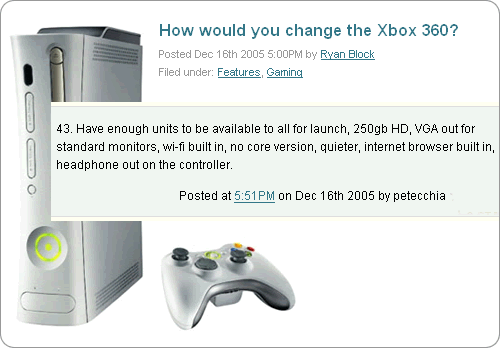![]()

CUSTOMER-MADE: time to tap into THE GLOBAL BRAIN! ![]()
Last updated: May 2006 | Let’s get this out of the way once and for all: trends are not one-off coining affairs. Some trends are worth tracking for years and years, especially if they represent a radically new definition of what constitutes value to consumers. INFOLUST is one of them. So is GENERATION C. And from a business and innovation angle, we’d like to argue that the CUSTOMER-MADE trend, co-creating with your customers, is the most important one to watch. Not because everything has to or will be co-created in the future, but because tapping into the collective experiences, skills and ingenuity of hundreds of millions of consumers around the world is a complete departure from the inward looking, producer- versus-consumer innovation model so common to corporations around the world.
So here’s yet another CUSTOMER-MADE update, exactly one year after our last coverage, bringing you new insights and hands-on examples of firms already profiting from co-creating with their customers. But first, let’s start with a recap:
![]()
CUSTOMER-MADE: “The phenomenon of corporations creating goods, services and experiences in close cooperation with experienced and creative consumers, tapping into their intellectual capital, and in exchange giving them a direct say in (and rewarding them for) what actually gets produced, manufactured, developed, designed, serviced, or processed.”
![]()

Consider any or all of the following:
- Status: people love to be seen, love to show off their creative skills and thinking.
- Bespoke lifestyle: something consumers have been personally involved in should guarantee goods, services and experiences that are tailored to their needs.
- Cold hard cash: getting a well deserved reward or even a profit cut for helping a company develop The Next Big Thing is irresistible.
- Employment: in an almost ironic twist, CUSTOMER-MADE is turning out to be a great vehicle for finding employment, as it helps companies recruit their next in-house designer, guerrilla advertising agency or brilliant strategist.
- Fun and involvement: there's pleasure and satisfaction to be derived from making and creating, especially if co-creating with brands one loves, likes or at least feels empathy for?

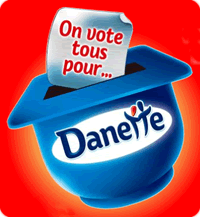 It’s NOT plain feedback without an answer, it's not Do-It-Yourself, it's not customization, it's not even personalization, as all of these actions take place after companies have decided what the basics are, which products and services and experiences they're willing to hand over to consumers. Case in point: consumer voting campaigns like onvotetouspourdanette.com or straightupflavor.com. Sure, they're fun, but at the same time have a hopelessly tired feel to them. Once true CUSTOMER-MADE becomes the norm, it should be the companies voting for whatever consumers choose to submit!
It’s NOT plain feedback without an answer, it's not Do-It-Yourself, it's not customization, it's not even personalization, as all of these actions take place after companies have decided what the basics are, which products and services and experiences they're willing to hand over to consumers. Case in point: consumer voting campaigns like onvotetouspourdanette.com or straightupflavor.com. Sure, they're fun, but at the same time have a hopelessly tired feel to them. Once true CUSTOMER-MADE becomes the norm, it should be the companies voting for whatever consumers choose to submit!
![]()
For decades, consumers have been saving up their insights and rants about the stuff they consume, simply because they didn't have adequate means to interact with companies, or with other consumers for that matter. No longer. These fickle, wired, empowered, infolusty, opinionated and experienced holders of a MC (Master of Consumerism) are getting used to 'having it their way', in ANY way imaginable, which includes wanting to have direct influence on what companies develop and produce for them.
It certainly helps that these same consumers are also part of GENERATION C: they're creative and increasingly have access to professional hardware, software, and online distribution channels to show (and dictate) companies what it is they expect from them, using text, sound, picture and video in ever more powerful ways. Add to GEN C the millions of lead users, early adopters, brilliant business professionals dying to give you a piece of their mind, and you’ll end up with THE GLOBAL BRAIN, waiting for you to tap into its experiences and skills. More on THE GLOBAL BRAIN in a future Briefing, but you probably get the picture: your brand's Next Great Idea could come from Sao Paulo or Singapore, if you open up your corporate fortress to smart individuals from around the world. If you don't, someone else surely will.

![]()
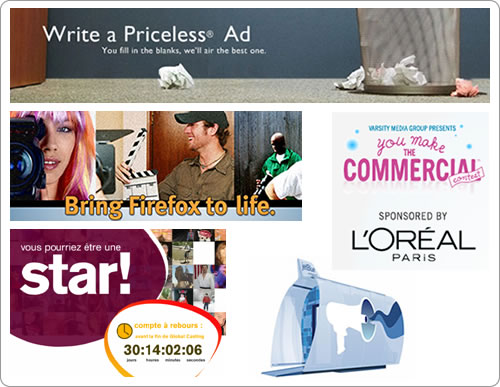
Virtually every brand these days seems to be inviting their customers to contribute to their next advertising campaign. If you believe that this is proof that co-creation is in fact an established trend, think again.
Sure, recent examples like L’Oreal’s You Make The Commercial, FireFox’s Flicks, MasterCard’s Write a Priceless Ad, JetBlue’s Travel Stories and McDonalds’ Global Casting are good fun (hell, if consumers really like your brand, they don’t even need a contest, as illustrated by these cool, unofficial American Apparel ads), but while getting some of your customers involved at a tactical marketing level is better than nothing, it doesn’t touch upon the truly massive opportunities that the CUSTOMER-MADE trend has to offer when you move beyond advertising: from product development to open-conversation feedback schemes:
![]()
The easiest way for brands to dip their toes into CUSTOMER-MADE and tap THE GLOBAL BRAIN is to announce product or service development contests, open to consumers from around the world.
Let’s start with some CUSTOMER-MADE contests held since our last update: they go beyond the usual ‘send-us-your-product-idea-and-win-a-voucher-for-a-free-ice-cream-
and-don’t-expect-us-to-actually-do-something-with-it’:
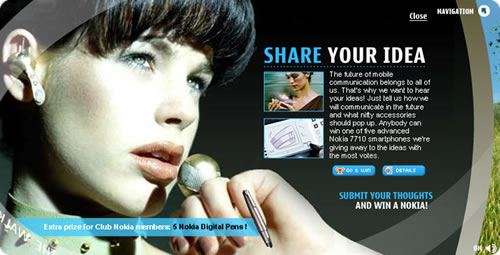
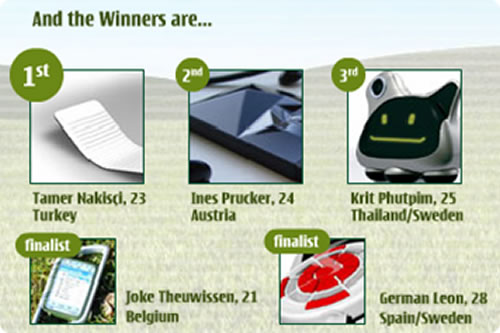
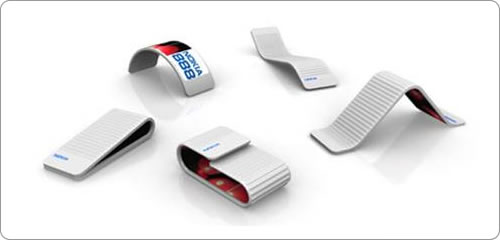 The Nokia Concept Lounge took place in summer 2005 (some brands DO get it, and surprisingly it's often the brands that already have a strong competence in design or product development: ;-), but we thought the initiative was too well executed to not mention in this update. The lounge invited designers in the Benelux to share ideas and design the next new cool phone. Not surprisingly, in a GLOBAL BRAIN world, entries came from all over, with the winner being a Turkish designer, Tamer Nakisci. His wrist-band style phone (the 'Nokia 888') must have had phone manufacturers from China to Finland drooling.
The Nokia Concept Lounge took place in summer 2005 (some brands DO get it, and surprisingly it's often the brands that already have a strong competence in design or product development: ;-), but we thought the initiative was too well executed to not mention in this update. The lounge invited designers in the Benelux to share ideas and design the next new cool phone. Not surprisingly, in a GLOBAL BRAIN world, entries came from all over, with the winner being a Turkish designer, Tamer Nakisci. His wrist-band style phone (the 'Nokia 888') must have had phone manufacturers from China to Finland drooling.
![]()
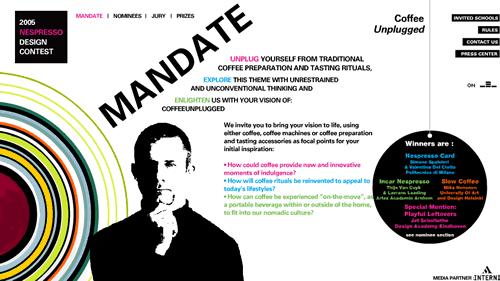
What goes for phones, also goes for coffee. Nespresso’s 2005 Design Contest aimed at imagining the future of coffee rituals, yielded gems like the Nespresso InCar coffee machine and the Nespresso Chipcard (which stores coffee preferences for registered individuals, and when inserted into a vending machine, communicates with a central database to brew a personalised cup of coffee). Pictures of the winning concepts can be found at gizmag.co.uk/go/5493/gallery. Do check out the Illy Design contest too, as featured in our previous update.
![]()
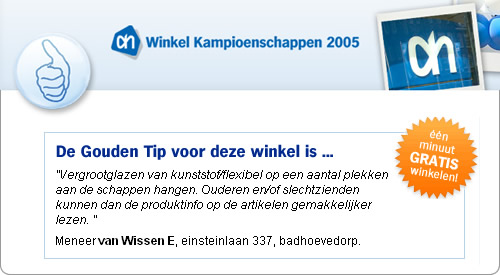
Hang plastic/flexible magnifying glasses from shelving units, making it easier for senior citizens and visually impaired people to read production information.
End of last year, Dutch supermarket chain Albert Heijn did something sensible: instead of installing suggestion boxes that customers don't use and stores don't empty, they asked customers for detailed feedback on how to improve their stores, through websites, leaflets and billboards. More than 55,000 customers took the bait, commenting on service, assortment and convenience levels in over 700 stores in The Netherlands. 700 submitters of ‘Golden Tips’ (which are online for all to see) won one-minute shopping sprees, with individual stores committing to implement suggestions as soon as possible.
![]()
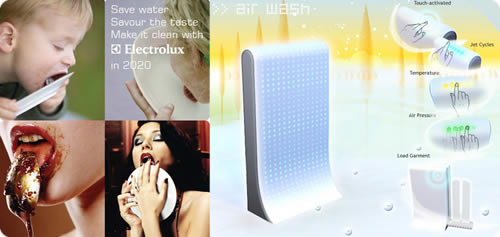

More design: the Electrolux Design Lab 2005 attracted entries from over 3,058 (!) design students from 88 countries around the world, the top six countries being the US, the UK, China, India, Brazil and Italy. (GLOBAL BRAIN, anyone?). Participants were asked to design household appliances for the year 2020. Twelve finalists participated in a six-day design event in Stockholm, including workshops, model building and a competition for cash-awards, appliances and more (click here for pictures of the winning concepts).
The competition’s registration process was run via Designboom, an industrial design community. A smart move, as CUSTOMER-MADE isn't always about involving hundreds of millions of contributors. There's no harm in targeting relevant pockets of expertise if you're inviting others to co-create something specific (for open conversation schemes, see further down below). More to come: the theme for the new Electrolux DesignLab 2006 is “Healthy Eating Habits in 2016”, asking for product ideas for food preservation and preparation.
![]()

What about automotive? You may remember our earlier coverage of Peugeot’s worldwide, bi-annual Concours Design which netted Peugeot the Moovie, a two-seat electric concept car designed by André Costa. The next contest will start this August, no doubt attracting an even more global crowd. Other car brands: get moving!
![]()

TV isn't exempt, either: The L-Word Fanisode competition called for co-creating an episode of the hit television show, assembling a full script, scene by scene. The contest ran from January - March 2006, with the show's real (paid) writers outlining a scene and giving guidance, giving fans about a week per scene to submit offerings, peruse others people's submissions, and vote. The grand prize winner got a script-writing session with L Word creator Ilene Chaiken and USD 2,000 credit at Saks Fifth Avenue. (Source: BusinessWeek.)
![]()

Stylish Japanese purveyor of all things minimalist Muji is also launching an international design competition, which is about to start, well, now. Calling on the entire GLOBAL BRAIN, Muji’s first theme is “SUMI”, (corner / edge / end). From the site’s briefing: “The objective is not to design something that is placed in the middle of the room, but towards the edges, not at the centre and not directly around the centre; you should look for somewhere that evades the eye, send us an object designed for that place, and name it as you wish. We are not asking for any particular genre, it could be anything from furniture, stationery and office equipment, to everyday items.” Just like aforementioned Nespresso, winners will be announced at the Milan Salone. Let’s see which CUSTOMER-MADE product pops up in Muji stores from Tokyo to London next year?
![]()
All of the examples above are a great way to really get started with CUSTOMER-MADE. But only a few companies have truly integrated this way of thinking into everything they do. One of the leaders in integrating CUSTOMER-MADE into its corporate fabric, P&G, is not slowing down: its Connect + Develop program and other innovation projects now produce more than 35% of the company’s innovations. In fact, R&D productivity at Procter & Gamble has increased by nearly 60%. In the past two years, P&G launched more than 100 new products for which some aspect of development came from outside the company. Among P&G’s most successful connect-and-develop products to hit the market are Olay Regenerist, Swiffer Dusters, the Crest SpinBrush, and the Mr. Clean Magic Eraser (source: HBR, March 2006).

P&G also recently rebranded its Tremor Moms program to Vocalpoint. In their own words: ‘’Vocalpoint is a unique marketing brand powered by the Procter & Gamble Company that helps companies do a better job developing products and services that moms care about and want to talk about. We work with this influential group of moms to help companies in industries that include entertainment, fashion, music, food and beauty. We collect feedback and generate valuable knowledge and insight for our clients through surveys, product sampling and previews of products and services.” P&G as the champion of CUSTOMER-MADE, to the point of selling its co-creation expertise to others. Not bad.
 What works for FMCG works for tech and appliances as well: Philips-owned LeadUsers.nl has just completed its second lead user centric project, which was all about discussing the quality of sleep. The site has been active since August 2005, and aims to bring together lead users (those consumers that face the needs that will be general in the marketplace, but face them months or years ahead of the rest of the marketplace, and are positioned to benefit significantly by obtaining a solution to those needs) to discuss various topics of interest to both Philips and participants. The first topic of discussion and research was video telephony: a number of participants received the latest in video telephony equipment to be tested at home. A new topic will be announced shortly. The website will give you some good cues for setting up your own lead users community, so sign up!
What works for FMCG works for tech and appliances as well: Philips-owned LeadUsers.nl has just completed its second lead user centric project, which was all about discussing the quality of sleep. The site has been active since August 2005, and aims to bring together lead users (those consumers that face the needs that will be general in the marketplace, but face them months or years ahead of the rest of the marketplace, and are positioned to benefit significantly by obtaining a solution to those needs) to discuss various topics of interest to both Philips and participants. The first topic of discussion and research was video telephony: a number of participants received the latest in video telephony equipment to be tested at home. A new topic will be announced shortly. The website will give you some good cues for setting up your own lead users community, so sign up!
![]()
Moving past contests and gifts, this is where it gets really interesting: co-creators receiving a cut of whatever gets developed based on their input, suggestions, design or ideas.
Check out:
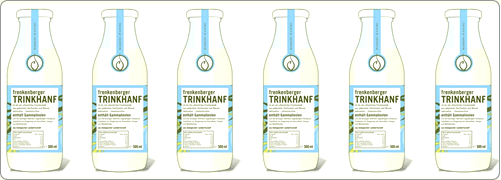
“Jetzt ist Ihre Kreativität gefragt!“ Austrian manufacturer Frenkenburger recently asked customers to come up with new flavours for its all natural hemp milk drink, Trinkhanf. Plain hemp milk is highly nutritious but tastes bland, so Frenkenburger previously launched mango/ginger, cocoa/vanilla/maple and coffee-flavoured varieties. To further expand the Trinkhanf line, Frenkenburger challenged creative customers to create tasty new flavours using fruits, herbs, or other natural ingredients. A panel of judges is now in the process of picking a winner, and the winning recipe will go into production. Aware that co-creators should share in profits, Frenkenburger will pay the winner one euro-cent per bottle sold. Granted, that's not exactly spectacular, but it beats a 25 dollar voucher ;-)
![]()
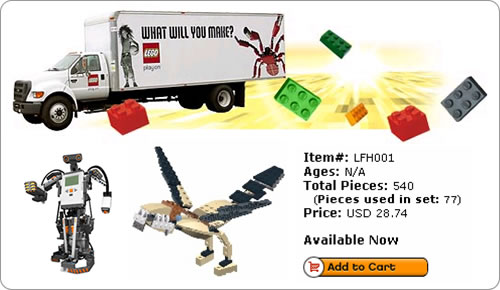
Another example of create and sell: LEGO’s LEGO Factory has been around for a while, but it remains an inspiring example of how to truly unleash THE GLOBAL BRAIN. Children and other building enthusiasts visiting the site are invited to design models (using easy to use, free downloadable software) and take part in competitions for LEGO prizes. A popular contest last year entitled winners to have their model mass produced and sold in Shop@Home, receiving a 5% royalty on each set sold. While customers can still upload their creations and have them become part of Lego’s official catalogue, the royalty scheme sadly has been nixed. Bring it back!
![]()
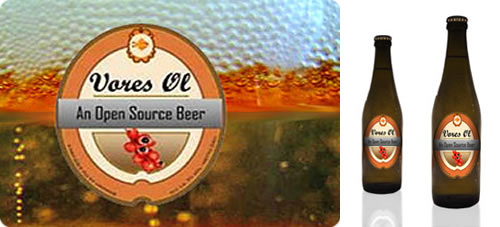
More CUSTOMER-MADE beverage innovation! Danish Vores Øl (‘Our Beer’) claims to be the world's first open-source beer. The recipe and the entire brand is published under a Creative Commons license, meaning that anyone can use Vores Øl's recipe to brew the beer or to create a derivative. As long as home brewers publish the recipe under the same license, they’re free to make money from their efforts, which includes free access to Vores Øl’s design and branding elements. Cheers!
![]()
Let's not forget CUSTOMER-MADE as an ongoing conversation, in many ways the Holy Grail of marketing. Think companies not just staging contests or asking for themed, detailed suggestions, but really hopping on the Cluetrain Manifesto. The following examples are a start...
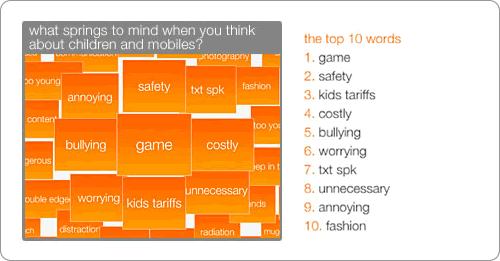
In the UK, Orange has set up Talking Point, where customers can tell Orange how they feel about all sorts of things - not just phones. Orange promises to listen, and to use the info to shape the way they think about and do things in the future. A number of questions (like “what in your life would you like to see technology improve?”) make it easier for visitors to share their thoughts. This isn't really a sparkling conversation, but it's better than nothing, in what is still very much a one-way arena.
![]()
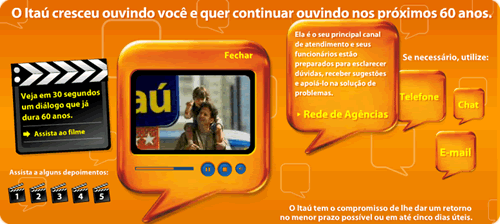
From April to October 2005, Itaú, Brazil's largest bank, launched a campaign titled "O Itaú quer ouvir você" , which means (how refreshing!) "Itaú wants to listen to you". Through a massive ad campaign, and by using channels such as dedicated 0800 numbers, e-mail, and online chats, employees at their banks, and actual telephones at ATMs, Itaú went far beyond the usual concept of suggestion boxes. They even promised to get back to participants in five working days, commenting on suggestions made. First results: an average of 7.200 requests, complaints, and suggestions per month.
![]()
 Equally laudable, Honda UK is sponsoring a new blog network, 2TalkAbout.com, that lets audiences publish their views on well-known brand as well as respond to other people's views. The motor company is the first brand to associate itself with the network: the site, called 2TalkAbout Honda is aimed at anyone with an interest in Honda cars, especially the newly introduced Honda Civic, and was launched as the new model was unveiled at the Geneva Motorshow.
Equally laudable, Honda UK is sponsoring a new blog network, 2TalkAbout.com, that lets audiences publish their views on well-known brand as well as respond to other people's views. The motor company is the first brand to associate itself with the network: the site, called 2TalkAbout Honda is aimed at anyone with an interest in Honda cars, especially the newly introduced Honda Civic, and was launched as the new model was unveiled at the Geneva Motorshow.
Although the online community will be completely independent from Honda, Honda engineers and associates will regularly log on to contribute to and respond to feedback, giving users direct access to the brand. (Source: Revolution.) Honda of course realises that it's better to participate than stand on the sidelines: online discussions on how to improve YOUR brand already are, or will soon be, everywhere. Witness the following:
![]()
To get a taste of how third parties are increasingly doing what brands themselves neglect to capitalise on, check out the highly informative, and often brutal, ‘How Would You Change or Improve’ topics that Engadget.com ("a web magazine with obsessive daily coverage of everything new in gadgets and consumer electronics") has been running. Their most recent one was for the Xbox 360. Other brands and services so far have included Tivo, Gmail, Skype, Creative Zen Vision, iPod video, Sony Ericsson W800, iPod nano, the Mighty Mouse, Google Talk, Motorola ROKR E1, Sony Ericsson P910, Electrolux Roomba, and the Mac Mini. This kind of aggregation of passionate lead users (we're talking consumers truly obsessed with gadgets here, who not only want to know about the latest, but also buy and use it) may yield your brand more insights and suggestions in a week than your innovation lab and market research department can come up with in a year!
It should come as no surprise that the unsanctioned ‘How Would You Change’ theme is catching on with avid users: other sites, part of Weblog Inc, who also publish Engadget, are chiming in:
![]()
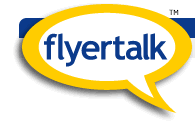 And to add just one more industry to this Briefing: in the world of hospitality, a similar phenomenon can be found on FlyerTalk.com, a community for avid (and highly profitable!) business travellers. In fact, so many suggestions and complaints for and about major hotel chains were piling up on that site, that Starwood Hotels and Resorts seconded William Sanders, better known as the Starwood Lurker, to keep an eye on the forums, 8 hours a day. Since he openly started participating in November 2002, the Starwood lurker has posted more than 11,000 replies, (which comes down to an average of more than 5 postings a day!), engaging in conversations with some of Starwood's most valuable customers. No word on how much money this has made Starwood, but we guess it's many times more than Mr. Sander's salary.
And to add just one more industry to this Briefing: in the world of hospitality, a similar phenomenon can be found on FlyerTalk.com, a community for avid (and highly profitable!) business travellers. In fact, so many suggestions and complaints for and about major hotel chains were piling up on that site, that Starwood Hotels and Resorts seconded William Sanders, better known as the Starwood Lurker, to keep an eye on the forums, 8 hours a day. Since he openly started participating in November 2002, the Starwood lurker has posted more than 11,000 replies, (which comes down to an average of more than 5 postings a day!), engaging in conversations with some of Starwood's most valuable customers. No word on how much money this has made Starwood, but we guess it's many times more than Mr. Sander's salary.
Now, you could of course decide that all of the above is too much work, or too expensive, and ignore it... (Yes, even multi-billion dollar brands have told us that finding the 'budget' for dedicating just one full-time person to personally monitor the thousands of conversations about their brand would be a real challenge.) But in a review-driven, transparent world, the alternative to CUSTOMER-MADE is finding out about your customers' feedback, suggestions, and yes, anger, through publicly accessible name-them (and sometimes shame-them) websites:
And so on! More on how to get started below, in the opportunities section.
![]()
 Some thoughts and observations on how the CUSTOMER-MADE trend may evolve:
Some thoughts and observations on how the CUSTOMER-MADE trend may evolve:
a. The media world is CUSTOMER-MADE's coal mine canary (thank you, Jeff Jarvis). We have deliberately avoided businesses that are completely by and for consumers, i.e. the user-generated content revolution, as that is everywhere now, AND we spoke about it at length last year. But one more observation about citizen journalism in particular: it provides inspiration to any brand wanting to turn its customers into 'reporters', sending in findings, observations, and suggestions. And as the model is spreading like wildfire,* expect more consumers to 'get' and enjoy the concept. Citizen Journalism as the open innovation model of the future?

* (OhMyNews, the South Korean ‘citizen participatory journalism’ showcase, now boasts 700,000 daily readers and 41,000 citizen journalists, who receive USD 20 for a newsworthy piece, is going international, with a helpful USD 11 million investment from Softbank. Or check out South African www.reporter.co.za, which pays contributors 5 euros per accepted story.)
b. Money talks: as co-creators get smarter AND realise how much they're worth, expect kick-backs for co-created goods and services to go up. If you don't pay a fair share, talented members of THE GLOBAL BRAIN will take their business elsewhere. So why not turn an inevitable development into a strength, handsomely rewarding the next Golden Tip, and creating the first CUSTOMER-MADE millionaire? The PR value and goodwill alone will be worth many times more.
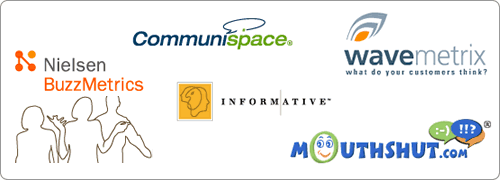
c. Intermediaries will reap riches: besides aforementioned 2TalkAbout.com, check out companies like Informative, Communispace, WaveMetrix, Buzzmetrics and MouthShut
who are helping to kick-start and manage the conversation and co-creation processes between 'producer' and 'consumer'. With traditional brands shit-scared to really open up to their customers, fearing the deluge of hitherto unanswered questions, complaints and suggestions, there's money in helping them get started in a controlled environment.
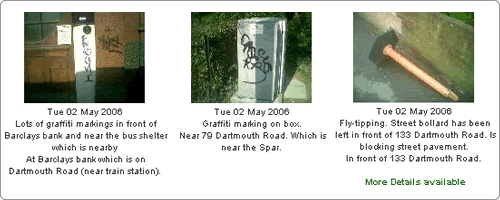
d. CUSTOMER-MADE will spread to non-businesses: politicians and city-governments are latching on. In Queens, NY, assemblyman Jimmy Meng (D-Flushing) is sponsoring a "Make Your Own Law" contest, inviting his constituents to write legislation with the promise that the best proposal will be introduced as a bill in Albany. (Source: Daily News.)
Meanwhile, in Lewisham, UK, residents are helping to keep the southeast borough of London clean in CUSTOMER-MADE/LOCAL BRAIN style: after installing special software on their cameraphone, observant townspeople can snap a picture of graffiti or overflowing litter bins, enter location details, and send it to the local council. The picture is then posted on the council's website, and cleaning crews are sent to resolve the issue. Read more on this initiative on our sister-site Springwise New Business Ideas. And yes, this comes close to citizen journalism as well!
e. THE GLOBAL BRAIN will grow and grow and grow: yes, capitalism is triumphant, but where some still see the incredible rise of the consumer society as a source of hundreds of millions of newly minted, free-spending consumers (in India, in China, in Brazil, in Russia, in Turkey, in Nigeria) purchasing finalised mass-goods, YOU of course are salivating over the thought of millions of freshly educated, highly informed, super ambitious professionals eager to join your global open-innovation team. ;-)
![]()

When condensed into keywords, the CUSTOMER-MADE trend is about innovation, which these days is the sole factor determining a company’s fortune or downfall. And as innovation CUSTOMER-MADE style implies the end of traditional producer/consumer relationships, implies letting go of control, and realising that the entire world could be your advisor, it also implies re-innovating innovation itself. Scary stuff for not-invented-here laggards, but heaven for those obsessed with truly involving smart consumers before they take their talent elsewhere.
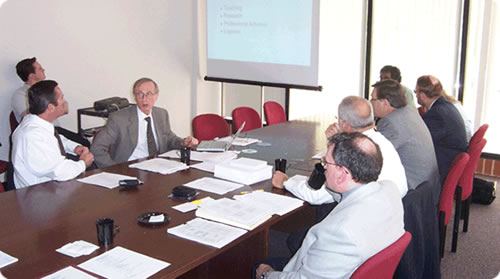
If this reminds you of your current Innovation Team…
So where on earth to begin? The many examples and insights above (together with our November 2004 and May 2005 overviews should provide you with a pretty solid starting point for your own brainstorming sessions, innovation summits, strategic away-days and what have you. Examples are useful to get inspired, and to convince other execs that this is really happening. And the insights and learnings are for you and your team who then have to develop a kick-ass strategy AND implement it.
So, to get started, what's stopping you from setting up your own ipodlounge.com, hiltonlobby.com, virgincabin.com, ingcounter.com, saabbackseat.com, safewayaisles.com, samsungcall-in.com, or vodafoneconnection.com, and inviting your customers to engage in CUSTOMER-MADE goods, services and experiences? Are you ready to open up (even as an experiment) one strategy meeting, one design process, one brainstorming session to the millions of consumers who may have an expert opinion, insightful suggestion, new business idea and so on, simply because they're your avid users, and, in the best case, biggest fans?
Oh, and if fear of a deluge of complaints and requests is holding you back: remember the deluge is already happening behind your back, and that if YOU aren't listening to your smart, able customers, someone else definitely is!
There are undoubtedly many other fears you may have, but there's a solution for every problem. Drop us an email if you're working on an interesting CUSTOMER-MADE project, and we'll send you some additional 'CUSTOMER-MADE Fears and Solutions' findings. You learn, we learn. ;-)
Furthermore, one trait that all of our trends have in common is that they seriously alter consumer expectations. Once they become accustomed to CUSTOMER-MADE being an option, consumers will take even less kindly to corporations who don't communicate, who don't respond to feedback, who don't use open source, who don't act upon suggestions, who keep throwing new stuff over the wall, hoping someone will like it. It's time to open up! (And yes, DO talk to us as well: trendwatching.com's founder Reinier Evers enjoys feedback, rants, praise and suggestions! Just email him at reinier@trendwatching.com.)
Email the CUSTOMER-MADE trend to a friend >>
CUSTOMER-MADE, Part 2 | May 2005
Picture by Bryan Boyer
"Get ready for CUSTOMER-MADE: the phenomenon of corporations creating goods, services and experiences in close cooperation with consumers, tapping into their intellectual capital, and in exchange giving them a direct say in what actually gets produced, manufactured, developed, designed, serviced, or processed. Consumerism will never be the same!"
CUSTOMER-MADE is getting bigger and bigger. Sure, we were bullish on this trend when we introduced it last November, but still, the sheer number of new CUSTOMER-MADE spottings and insights surprised even us. To refresh your memory:
"For decades, consumers have been saving up their insights and rants about the stuff they consume, simply because there were no adequate means to interact with companies, or with other consumers for that matter. No longer. These fickle, wired, empowered, informed, opinionated and experienced holders of a MC (Master of Consumerism) are getting used to 'having it their way', in ANY way imaginable, which includes wanting to have direct influence on what companies develop and produce for them.
It certainly helps that these same consumers are also part of GENERATION C: they're creative and increasingly have access to professional hardware, software, and online distribution channels to show (and dictate) companies what it is they expect from them, using text, sound, picture and video in ever more powerful ways."
What better way to become part of this trend than to learn from companies who already have embarked on a quest to become co-creators instead of obsolete DIY-ers? Please study the following new CUSTOMER-MADE examples (spanning the B2C spectrum from potato-chips to cars, and the globe from Brazil to Sweden), followed by a number of new CUSTOMER-MADE learnings. For your convenience, we're introducing five broad CUSTOMER-MADE categories: Consumer Marketers, Expert Outsiders, Amateur Outsiders, Remix Culture and User Generated Content 2.0.
There is no stopping the trend of creative consumers contributing to, or even owning your advertising campaigns, both authorized and behind your back. Why? To feature on a website or billboard, or have one's home-made commercial downloaded by hundreds of thousands of fellow consumers is just too much fun. We previously highlighted CUSTOMER-MADE campaigns orchestrated by Mercedes, Mazda and Coors Light, now add:
• While Nike was basking in the glory of Tiger Woods' winning shot at the Masters Golf (GA) tournament, which involved a swoosh-brandishing golf ball getting priceless air time, Joseph Jaffe immediately created and uploaded what no doubt will or should become the next Nike commercial: www.jaffejuice.com/2005/04/tiger_did_it_ak.html.
• Last winter, Dutch comedy TV show 6Pack, (which brings together six people who have little to no television experience), set in motion a more than successful quest for the best CUSTOMER-MADE commercials, resulting in one million downloads for the most popular submission, a Sara Lee commercial (Yo Oma), featuring a 50 Cent loving, street-wise granny. Other brands participating in this contest that were lucky enough to attract GENERATION C's inventiveness: Pringles, Senseo, Clearasil, and ABN Amro Bank. Winning 'directors' were guaranteed TV air time and pocketed EUR 2000. A new contest is in the making (probably starting September of this year), and 6Pack, which is sponsored by Heineken, will be rolled out internationally soon. (Source: Springspotter Network, Maurits van Rijckevorsel.)
• The Converse Gallery should really have been part of our initial CUSTOMER-MADE piece, as it was launched last August, and has since then set the standard for CUSTOMER-MADE commercials. The site features dozens of 24-second films, CUSTOMER-MADE by Converse fans, who are asked to express what Converse shoes mean to them. The chosen films are then broadcast on Converse's website, with the possibility of being aired on MTV and other cable networks. With hundreds of submissions and millions of visitors ever since, this is one tasty source of CUSTOMER-MADE inspiration.
• Going after the Converse demographics, Cadillac invited members of GENERATION C to contribute to their series of five second commercials, which illustrated the speed of its CTS-V model, which can accelerate from zero to 60 in five seconds ("what ever you do, don't blink"). Amateur filmmakers could submit their own 5-second spots (and win air time), with one of the chosen directors also getting the keys to a brand new CTS-V. (Source: Adrants.) While the initial website now links to a CTS-V homepage, one of the 5 seconds ads can still be viewed at Ifilm.
• And going from cars to crisps: In Turkey, Ruffles chips launched a football themed CUSTOMER-MADE TV commercial campaign, called Ruffles Idea-logy, airing the 10 winning commercial scripts on national TV and rewarding the creators with an iPod. (Source: Springspotters, Bilgen Aldan and Ozlem Hanoglu.)
Marketing and advertising sure is fun, but true CUSTOMER-MADE involves co-created goods, co-created services, co-created experiences! So, waking up to the fact that there are hundreds of thousands of experts, innovators, inventors and so on outside company walls, research labs and innovation units at large corporations are increasingly NOT going it alone. Check out the following initiatives aimed at tapping expert outsiders (often designers and artists) for potentially lucrative new ideas:
• Last summer, Core 77, the industrial design site, teamed up with watch maker Timex for a global design competition called Timex2154: THE FUTURE OF TIME (celebrating Timex's 150th anniversary). Designers from more than 72 countries explored and visualized personal and portable timekeeping 150 years into the future, resulting in over 640 entries. Winners can still be viewed online, and in the Timex Museum.
• In the same vein, Illy Cafe teamed up with Domus magazine in April 2004, asking students and designers under the age of 35 to create new ways of enjoying coffee ("create a place for meeting, discovery and encounter"). Over the course of 10 months, 704 entries were received, roughly half coming from outside Italy. The best 14 projects were exhibited in Milan this month (April 2005). The winning concept is an escalator which functions both as a coffee machine and an art show. Coffee is served at the bottom of an escalator. On the way up, customers sip their coffee and enjoy a brief art exhibition. At the top of the escalator, they throw their plastic cup into a recycling machine that instantly molds it into a ticket for an art exhibition or show. Also noteworthy is the Illyvator, by Bryan Boyer. If this doesn't make you want to set up your own CUSTOMER-MADE contest, what will!? (Source: Springspotter Network, Michell Zappa.)
• The third Peugeot Concours Design was launched in September 2004 at the Paris Motor Show, and the final results were shown at the Geneva Motor Show last month. After aspiring car designers were asked to design the Peugeot of their dreams for the near future, 3,800 projects (compared with 2,800 in 2002 and 2,050 in 2000) were sent in, from 107(!) countries. This year's winner was the Moovie, a two-seater vehicle for urban use by André Costa, a Portuguese industrial design student. The full-scale model of his design will be unveiled at Peugeot's stand at the Frankfurt Motor Show in September 2005. (Source: Springspotter Network, Özgür Alaz.)
• In South Korea, mobile carrier KTF has held a contest to design new cell phones based on a "Cell Phone of Sensibility" theme, with a focus on usability and style. Just last week, 19 winners were announced, and a few of them may see their creations end up in Korean stores soon. (Sources: Engadget, Slashphone.)
Note: yes, we know that design contests have been around for quite a while, but what is truly new is the global scale on which companies can now reach out to the best and brightest. If one key driver behind CUSTOMER-MADE is a consumer who demands to be involved and in control, the other driver surely is ONLINE OXYGEN, which enables this need.
• A more ongoing approach involving outside experts can be found at Procter & Gamble, which launched its dedicated Connect + Develop program about five years ago, with the goal of having at least 50% of its new products derived from ideas generated by non-employee experts. Beside its own R&D employee base of 7,000, the company now has access to millions of potential innovators. The results so far? Everything from Swiffer Wet Jet, Olay Daily Facials, Crest Whitestrips & Night Effects to Mr. Clean Autodry, Kandoo baby wipes and Lipfinity. (Source: Tech Central Station, Industry Week.)
If 'experts' still conjure up images of bespectacled geniuses donning white lab coats or black turtlenecks, it's time to get with the Pro-Am revolution: in a world dominated by the Creative Class, we're all amateur experts! So here's an overview of companies tapping EVERY user's mind, not just experts, for divine inspiration and award winning goods, services and experiences, bringing amateur outsiders fame if not money:
• IKEA's "fiffigafolket" contest (Swedish for 'ingenious people') which just came to an end, and is now in jury-phase, asked amateur outsiders to send in clever designs for storing home media (hifi sets, TV, DVD etc) in the living room. Out of 5,000 ideas submitted, fourteen winners will be invited to IKEA headquarters for a workshop, and will receive EUR 2,500. More interestingly, the designs will actually get produced and end up in IKEA stores for all to see, buy and assemble. (Source: Springspotter Network, Okee Williams.)
• Copenhagen's 3 star Park Hotel became the Hotel Fox this April 2, as Volkswagen 'adopted' the venue to promote its new Fox model. After inviting 20 street artists, graphic designers and illustrators to redo the 61 rooms, consumer-artists too were asked to submit designs for the one room that is still in its original non-splendour. No word on the winner yet, but he or she gets to spend two weeks in Copenhagen to implement his or her ideas with the help of an interior designer. (Source: Springspotter Network, Jason Park.)
• CUSTOMER-MADE pioneer Jones Soda has been letting its customers create 'custom soda labels' by submitting their own photos for a long time now (their label gallery now contains an astounding 285,285 pics); some of these are chosen as permanent, wide-distribution labels for Jones soda. In true CUSTOMER-MADE style, the Seattle based beverage company also actively asks for feedback on possible new flavors. (Source: Springspotter Network, Charlene Rooke.)
• In Brazil, Kaiser Beer embarked on a CUSTOMER-MADE adventure last year by asking their customers to co-create its Kaiser Novo Sabor: a new premium beer reflecting the opinions and personal taste preferences of more than 11,000 contributors in 130 cities across Brazil. The beer was an instant hit, with the initial 11,000 contributors eager to play the role of brand ambassador. (Source: Springspotter Network, Paula Rizzo.)
And the list goes on, from apparel to salads:
• At Threadless, an ongoing t-shirt design competition urges users to submit shirt designs, which are put into the running to be scored for seven days. After those seven days, the highest scoring designs are chosen to be printed and sold in the shop section. A similar concept is pursued by Dutch Buutvrij, while CUSTOMER-MADE fabrics can be found at
• There's cold hard cash to be made at OriginalSnowboartArt.com, where customers design snowboard graphics and receive a percentage of the proceeds when they're sold. (Source: Springspotter Network, Jason Sturgill).
• Edible CUSTOMER-MADE examples include Olvarit and Sumo Salad, the latter inviting customers to mix it up and suggest new salads on its site: every month one new CUSTOMER-MADE salad is selected, ending up on Sumo's official in-store menus (source: Springspotter Network, Özgür Alaz.) Catering to a younger audience is Netherlands-based Olvarit, who urged mothers to send in their favourite healthy baby food recipes. This resulted in a spanking new product line, Mama's Choice, which features eight winning meals, from Josine's 'French vegetables with ham' to Barbara's 'Fish stew with banana'. Needless to say, a picture of mother and child appeared on the labels of the food they CUSTOMER-MADE.
• On a grander scale, and starting two years ago as a pilot, the BMW Customer Innovation Lab was BMW's first true CUSTOMER-MADE environment. Participants were handed an online tool-kit, helping them develop ideas and showing how the firm could take advantage of advances in telematics, online services and driver assistance systems. From the 1,000 customers who used the tool-kit, BMW chose 20 and invited them to meet its engineers in Munich. BMW worked with German CUSTOMER-MADE intermediary Hyve to set up the service, just like Audi did when it ran its Audi Virtual Labs in 2001 and 2004. The Audi lab was focused on the development of 'infotainment' systems, gathering information about consumer expectations, preferences and upcoming trends in the infotainment world. A total of 1,662 consumers participated, designing their own individual infotainment consoles, expressing 219 service ideas, giving 261 comments on a prototype console, and contributing 728 visions of future cars. Not bad ;-)
Closely related to CUSTOMER-MADE, with a healthy dose of open-source mentality added, is the burgeoning Remix Culture, spearheaded by hackers, but now embraced by savvy consumers who are either tired of having to deal with goods and services that don't do what they want them to do, or who want to combine the best features of various offerings. Think Paul Rademacher's clever pairing of Google Maps with Craigslist Classifieds, mapping by price range all properties for sale or rent in specific areas. Which actually delighted Google (no, not all companies freak out when users improve what's on offer) who not too coincidentally just launched code.google.com, a new tool for the other Pauls of this world, giving access to free source code and lists of Google's API services.
• Remix Culture is also about clever programmers modifying Sony's Portable PlayStation days after it hit the shelves Only days in the US this March; remix fanatics have added chat and TV to the device's functionalities, cleverly capitalizing on the PSP's WiFi connection and other built-in, semi-locked online capabilities.
• Is Remix Culture a techie-only affair? Nope. It works just fine for sneakers, too: all over the web, sneaker freaks are uploading pics of their 'remixed' shoes; check out French Shoes-Up, a gallery where Adidas customers display their own version of Adidas' Superstar line, celebrating its 35th anniversary (see picture above). And who by now hasn't heard of the Adidas Zissou sneakers featured in the movie 'The Life Aquatic'. White/yellow sneakers with light blue striping (see below), these fictional shoes had thousands of sneaker freaks lusting after them, until remixers not only designed and produced their own - the DIY guide is still online - but also put them up for sale on eBay earlier this year. (Source: Springspotter Network, Bertrand Carton.)
What if your customers would actually provide all your content, not just a few TV commercials or one or two new products? For full blown CUSTOMER-MADE, look no further than the more than turbulent world of media: citizen reporters, consumer reporters, or whatever you want to call them, are HOT. Check out:
• Tate Britain in London is running a Write Your Own Label scheme. Visitors of the museum's website are asked to contribute their thoughts on how paintings should be described, and the chosen submissions are then displayed next to the paintings in the actual galleries. There's a nice touch of GRAVANITY in here too! (Source: Springspotter Network, James Davis.)
• A decidedly grass-roots approach to publishing, JPG Magazine features photographs taken by contributing (amateur) photographers who primarily work online, but want to share their work in print. Each issue is centered around a theme, and anyone can submit a photo via JPG's website.
• Taking a cue from CUSTOMER-MADE knowledge pioneer Wikipedia, Microsoft's Encarta is now testing a system that allows readers to suggest edits or additions to entries in its encyclopedia. Editors will still check contributions for factual errors or evidence of bias. Meanwhile, the number of topics/articles on Wikipedia runs in the hundreds of thousands.
• And to prove that user generated content is fast trumping any kind of traditional guide, listing, or other limited overview, look no further than IgoUgo. The online travel community's 350,000 members offer what traditional guidebooks can't: hundreds of thousands of opinions on more than 4,000 destinations across the globe, plus suggestions and photos for everything from cheap eats and luxury accommodations, to must-see attractions and worthwhile day trips. (Source: Springspotter Network, Elizabeth Miles.)
It's actually not hard to see how any business dependent on global, 24/7 content feeds will have to embrace CUSTOMER-MADE to stay attractive. Which then brings us to... major news organizations, forced to take a cue from the OhMyNews.com format, not to mention the blogosphere:
• The BBC is actively encouraging customers to submit pictures and videos, which may then be used immediately on any BBC News outlet, or end up in the In Pictures of the BBC website. Cleverly, not only does the BBC tell citizen reporters where to email their content to, they also provide a cell phone number, so camera phone pics can be MMS-ed instantly.
• The Guardian has launched an appeal to readers to get snapping with their mobile phone cameras to generate coverage for the UK's forthcoming elections. The Blair Watch Project urges readers to email or MMS their pictures to The Guardian's Flickr account. They'll be available for public viewing, with the best pics republished in The Guardian's blog. (Source: The Mobile Technology Weblog.)
• A less temporary approach can be found at NowPublic.com. From their website: "Seeing is believing, and you need to see more. Corporate news is missing this story. Again. You searched and there's no decent footage. You need NowPublic. Assign the story. Get photos, video, audio files posted to your request by citizen journalists on location. See the truth for yourself and show the world. NowPublic makes it easy to track down the real story and get the proof you need. Turn your blog posts into photo assignments. Watch fellow members vote to prioritize your story and chase down the footage. Give them a budget or recruit volunteers. Either way, the news is NowPublic."
• Promising to be equally entertaining (and disruptive) is Google Video Upload. Their tagline "Your work deserves to be seen" promises more GENERATION C meets CUSTOMER-MADE fun (not to mention another NOUVEAU NICHE accelerator). From the beta site (for now, users can only upload content; editors will be scanning and indexing the content before putting it live): "Whether you produce hundreds of titles a year or just a few, you can give your videos the recognition and visibility they deserve by promoting them on Google - for free: we're now accepting video from anyone who wants to upload content to us. As the content owner, you decide whether you'd like to give away your video for free or charge a price that you set for it. If you do charge a price, Google will take a small revenue share to cover some of our costs". Mmm... GENERATION C actually making money from their creations: TRENDWATCHING.COM approves.
Which then brings us to CUSTOMER-MADE TV networks:
• On Al Gore's new Youth TV network, Current, programming will to a large extent be comprised of viewer submissions, which can be uploaded to the network's website. From Gore's launch statement': "The Internet opened a floodgate for young people whose passions are finally being heard, but TV hasn't followed suit. We intend to change that with Current, giving those who crave the empowerment of the Web the same opportunity for expression on television."
• The people of Engerwitzdorf, Austria are filming, editing and producing their own regional news channel. The channel, Buntes Fernsehen, covers local politics, sports, events and anything that residents want to film and are prepared to upload for others to watch on PCs.
• Canadian BITE TV is taking the citizen's media/blogging approach to television. BITE will offer viewers the opportunity to submit their own video content including make-your-own television ads.
• Not to be outdone, Canadian Broadcasting Corporation's ZeD is a late-night, arts-and-culture program that mixes amateur movies with independent film and studio-produced content. ZeD allows viewers to shoot, edit and upload their own short-form videos to the show's website. ZeD receives between 200 and 300 viewer-produced videos per day, and employs a team of online editors to sift through the content, check it for copyright issues and either publish it on its website or pass it along to a producer who will give it a coat of professional polish, if needed.
Expect the media business to seriously feel the impact of the CUSTOMER-MADE trend in the very near future: thanks to an abundance of new channels (mobile, IP based TV, online niche publishing), an insatiable need for more content will fuel Consumer Generated Content 2.0. Consumers' appreciation of more opinionated, authentic, non-corporate owned material doesn't hurt either. And as everything avant-garde eventually becomes mainstream, this is what you want to keep a close eye on, and learn from the developments, before CUSTOMER-MADE hits your own industry full force.
Examples are useful to get inspired, AND convince other execs this is really happening; insights and learnings are for you and your team who then have to develop a kick ass strategy AND implement it. So here we go:
• Consumers are into CUSTOMER-MADE because they can:
- get and control exactly what they want and need at their own terms
- show off their creative skills or even become famous
- make money from their contributions and involvement
• If CUSTOMER-MADE reminds you of some of your B2B strategies, you're right. In fact, the way you're already closely collaborating with your suppliers may well be applicable to your CUSTOMER-MADE strategies. More to follow on this in our next update.
• CUSTOMER-MADE is a great alternative to traditional marketing: if you co-create products, participants obviously don't need to be 'told' about the product, plus they are far more likely to act as brand ambassadors.
• In a review driven and transparent world, the alternative to CUSTOMER-MADE is finding out about your customers' feedback, suggestions, and anger through publicly accessible name-them-and-shame-them sites.
• And in an almost ironic twist, CUSTOMER-MADE is turning out to be a great vehicle for recruiting the next in-house designer, guerrilla advertising agency or brilliant strategist. It's the trend that keeps on giving ;-)
Yes, CUSTOMER-MADE is a Big Trend. So where on earth to begin? The many examples and insights above (together with our November overview), and rereading our GENERATION C trend should provide you with a pretty solid starting point for your own brainstorming sessions, innovation summits, strategic away-days and what have you.
Next for the CUSTOMER-MADE revolution? How about CUSTOMER-OWNED? As the number of CUSTOMER-MADE initiatives grows exponentially, savvy members of GENERATION C will demand serious compensation if not a fair percentage of whatever it is they've co-created with you. Soon, a simple iPod in exchange for designing the firm's Next Big Thing just won't do. Also expect a slew of intermediaries coordinating millions of knowledge exchanges between producers and consumers, from talent brokers to project managers.
CUSTOMER-MADE, Part 1 | November 2004
Marketing has finally become a conversation. Not, in most cases, as was intended, BETWEEN corporations and consumers (that would make too much sense), but rather a global conversation involving millions of consumers ABOUT corporations. On sites like Planetfeedback.com, thecomplaintstation.com, Epinions, About.com, on hundreds of thousands of blogs, community sites, forums, viral emails, bulletin boards, and what have you, consumers relentlessly exchange views, complaints, opinions and comments about products and services, about brands, about companies, about YOUR company.
Why now? Because they finally can. For decades, consumers have been saving up their insights and rants about the stuff they consume, simply because there were no adequate means to interact with companies, or with other consumers for that matter. No longer. These fickle, wired, empowered, informed, opinionated and experienced holders of a MC (Master in Consumerism) are getting used to 'having it their way', in ANY way imaginable, which includes wanting to have a direct influence on what companies develop and produce for them.
It certainly helps that these same consumers are also part of GENERATION C: they're creative and increasingly have access to professional hardware, software, and online distribution channels to show (and dictate) companies what it is they expect from them, using text, sound, picture and video in ever more powerful ways.
Sure, some companies ARE now engaging creative customers in new ways. Recently, brands like Coors Light and Mercedes Benz invited customers to co-create advertising campaigns, with Mercedes encouraging proud owners of a Benz to submit snapshots of themselves next to their automotive objects of desire. And Mazda and Conde Nast have just partnered to create a similar contest whereby contestants can submit photos representative of their interpretation of Mazda's "Zoom-Zoom" slogan. (Thanks, Adrants.com!)
These companies are clearly aware that tapping into the collective intellectual capital of their customers yields great creative and 'real' content. However, let's not make the mistake to think that in the end these conversations will all be about communications and branding: how about extending this cooperation with consumers to virtually everything a corporation does, by making the customer an integral part of ALL creative and creational processes?
TRENDWATCHING.COM has dubbed the latter "CUSTOMER-MADE": the phenomenon of corporations creating goods, services and experiences in close cooperation with consumers, tapping into their intellectual capital, and in exchange giving them a direct say in what actually gets produced, manufactured, developed, designed, serviced, or processed. The CUSTOMER-MADE trend has been slowly building over the last five years, but with the current onslaught of consumer activism and the rapid rise of GENERATION C, it finally seems ready for its big moment in the limelight, where TRENDWATCHING.COM expects it to stay for many years to come. It doesn't hurt that Management Guru C.K. Prahalad recently published 'The Future of Competition' an insightful and highly recommended book on co-creation, which prompted us to move CUSTOMER-MADE to the top of our emerging trends list!
Mind you, CUSTOMER-MADE is NOT plain feedback, it's not Do-It-Yourself, it's not customization, it's not even personalization, as all of these happen after companies have decided what the basics are, which products and services and experiences they're willing to hand over to consumers, who can then (at best) modify certain elements, change a color, replace a cover. That's still pretty much a one-way conversation, business as usual.
So what DOES qualify as CUSTOMER-MADE? Check out the hands-on examples below; a random yet varied overview of CUSTOMER-MADE initiatives, both 'corporate' initiatives and grassroots movements, which should get you going.
• • • •
Last year, 120,000 people around the world signed up to join Boeing's World Design Team, an internet-based global forum that encourages participation and feedback while the company is developing its new airplane. Activities include message boards, conversations with the Boeing design team, and extensive discussions on what members like and don't like about air travel today, as well as features they'd like to see in their dream airplane. In Boeing's own words: "Flyers and aviation enthusiasts from around the world are sharing the excitement of creating the airplane of the future."
• • • •
Shoe designer John Fluevog has a section on his site entitled Open Source Footwear, wherein serious Fluevog owners can submit designs for future shoes. The winning design actually gets put into production. CUSTOMER-MADE at its best!
• • • •
A lot of talking and commenting goes on at www.niketalk.com, the non-affiliated online sneaker community which so far has received more than 200 million visits and 3.5 million posts. Every Sunday at 9 PM EST, their sister site, chat room NikeChat, welcomes Nike fans from around the world, to exchange views, tips and more.
A similar set up for new Mini Cooper owners can be found at www.mini2.com, for Lego fanatics at news.lugnet.com/dear-lego (BTW, Lego itself allows programmers from outside the company to access to the code that controls its Mindstorm toy robot, leading to an increased range of activities the robot can perform, in ways the company never imagined), and for TiVo users at www.tivocommunity.com. About the latter: for the past four years, the 65,000 members of the self-organized TiVo Community forum have traded ideas on 'how to convince friends and family to buy a TiVo', 'how to deliver impromptu sales training sessions to Best Buy employees whose sales pitches need work', or 'how to be a better TiVotee'. CUSTOMER-MADE sales teams anyone?
• • • •
At www.ipodlounge.com, avid iPod users (and aren't they all?) congregate not only to talk about their favorite device, but also to show the world (and thus Apple) what they would like the next iPod to do and to look like, or adaptations they've already created in their basement or garage. A fascinating combination of GENERATION C and future CUSTOMER-MADE trends if we ever saw one. The site gets more than 5 million hits a day, and if we were Apple designers, or Steve Jobs for that matter, we'd visit iPod Lounge weekly to get a good dose of CUSTOMER-MADE inspiration, and probably recruit loads future employees while we were at it.
• • • •
TRENDWATCHING.COM is all in favor of conversations taking place in the vicinity of beverages. Which is why we think Philips Streamium Café is aptly named. It's where owners of Philips' new WiFi TV sets and hifi systems tell Philips where they think Streamium is going, and what Streamium should be able to do. Current discussions involve everything from the time format on the appliances' display to 'Support for Real Player RadioPass + Real Rhapsody.' How long before the discussion turns to the question of which OTHER Philips appliances should become WiFi enabled?
• • • •
Online Lovemark Google has always been open to suggestions and comments from its millions of users: Google's social networking site Orkut includes two communities with over 1,000 subscribers: "What Should Google Do?" and "What Should Orkut Do?" And on Google's own business blog, visitors are encouraged to send their suggestions to gblog@google.com. And, gasp, they actually reply. A CUSTOMER-MADE treasure trove: who does NOT have some strong (and cool) views on what Google should do next?
• • • •
To prevent even more of you complaining about TREND-WATCHING.COM's newsletters getting too long (see, we're listening! ;-), we will only touch upon the now familiar CUSTOMER-MADE initiatives in the world of software. Let's not forget that Microsoft 'invites' millions to download beta versions of its software to test and improve, and don't even get us started on the Open Source revolution (under Open Source, thousands of volunteer programmers communicate over the Net to create, and continually improve, computer software products). At SourceForge.net alone, 883,000 registered users are cooperating on 80,000 Open Source software projects. We haven't seen anything yet!
• • • •
CUSTOMER-MADE games anyone? From Wikipedia: "Mod or modification is a term generally applied to computer games, especially first-person shooters such as Quake, DOOM and Half-Life, but also to real-time strategy games such as Warcraft III, Total Annihilation and the Command & Conquer series. Mods are made by the general public, and are entire new games upon themselves. They can include new items, weapons, characters, enemies, models, modes, textures, levels, and story lines. They also usually take place in unique locations."
One great CUSTOMER-MADE example is Counter-Strike, which started out as a Mod for Half-Life about four years ago. Counter-Strike is downloaded and then runs on top of legal versions of Half-Life. It now sells more copies than the original game itself: upwards of 1 million games per day are hosted on dedicated servers.
Other great Mod examples are TheForce.net, which collects Mods that make non-Star Wars games into proper Star War experiences, and Desert Combat, a modern day military modification to the popular war game BattleField1942 from EA. And with games quickly becoming entertainment choice NUMBER ONE for the Digital Generation, you may want to learn from CUSTOMER-MADE examples from this industry whether you're in FMCG or banking. This is where CUSTOMER-MADE excitement and innovation will blossom for a long time to come!
• • • •
And what about the open marriage between CUSTOMER-MADE and user-generated content? Check out four-year-old South Korean OhMyNews. This online newspaper works with 26,000 'citizen reporters', who send in stories and pictures which make up 80% of all content. OhMyNews pays up to USD 20 per article, though for many citizen reporters, getting their name in the paper is the real reward. Fiercely outspoken, OhMyNews has successfully challenged the traditionally conservative press in South Korea. CUSTOMER-MADE AND CUSTOMER-READ indeed!
In Holland, popular 24/7 news site NU.nl encourages readers to send in breaking-news pictures (since virtually everybody owns a digital camera or camera phone these days). The best images are also sold to ANP, the country's main news agency, who then pays these citizen photographers up to EUR 60 per shot.
• • • •
Yes, another Apple example, this one partly 'owned' by Apple. At Apple's iTunes store, user-created playlists enable customers to upload their favorite music selections and share them with other customers, who can then buy the songs if they like what they hear.
Needless to say, it was Amazon.com who pioneered this kind of CUSTOMER-MADE service, with their sophisticated recommendation system and customer book reviews, resulting in some of the most popular features of the Amazon.com site being entirely CUSTOMER-MADE.
• • • •
The travel community meets at the Lonely Planet Thorn Tree, an online bulletin board with over 5,000 posts a day (Lonely Planet also receives around 1,000 emails and letters a week from customers, helping them to constantly fine-tune their content), and at Virtual Tourist, where 400,000 members from over 219 countries share insights and experiences to help each other travel smarter, from finding the best place to get great airfares, accommodations or car rentals, to solid insider advice on what to see and do. In their own words: "VirtualTourist members are a friendly and helpful bunch and it's a snap to use the collective experience and brain power of our members to get the help you need."
OPPORTUNITIES
Is the CUSTOMER-MADE trend spanking new? No. But with the gap between traditional business practices and truly empowered consumers now reaching significant proportions, the CUSTOMER-MADE trend will further accelerate, moving from fringe trend to mega trend. In fact, CUSTOMER-MADE may turn out to be one of the most exciting and long term engines behind change and innovation that the world of business has seen in years: a way of thinking that has the power to redefine the relationship between customer and brand, between consumer and producer, something that taps into the most awesome reservoir of intellectual capital ever assembled. If that's not enough to invoke spontaneous brainstorming sessions, TRENDWATCHING.COM doesn't know what is.
In future updates on this trend, we'll address topics like what makes certain brands more suitable for CUSTOMER-MADE than others (could it be the Lovemarks concept?). Or how to use CUSTOMER-MADE as a recruitment tool. And we haven't even spoken about the risks that may exist in sharing everything with your customers (and thus inevitably with your competitors); new competition from 'amateurs' (think the already visible blurring between professionals and amateurs in journalism, design and software); or the fact that consumers don't always know what they want (even though they definitely know what kind of service they need, or what constitutes a good experience!). We're also not saying that everything and anything will be suitable for full blown CUSTOMER-MADE strategies. But the eclectic examples above should inspire you to find at least one or two ways to apply this trend to your own business.
So, to get started, what's stopping you from setting up your own ipodlounge.com, hiltonlobby.com, virgincabin.com, ingcounter.com, saabbackseat.com, safewaysaisles.com or vodafoneconnection.com, and inviting your customers to engage in CUSTOMER-MADE goods, services and experiences? Are you ready to open up (even as an experiment) one strategy meeting, one design process, one brainstorming session to the millions of consumers who may have an expert opinion, suggestion, new business idea and so on, simply because they're your avid users, and, in the best case, true fans?
Oh, and if fear of a deluge of complaints and requests is holding you back: rest assured the deluge is already happening, and that if YOU aren't listening to your smart, able customers, someone else definitely is! >> Email this trend to a friend.
Note: special thanks to Michell Zappa!
